Structural Enzymology of Cellvibrio Japonicus Agd31B Reveals Alpha-Transglucosylase Activity in Glycoside Hydrolase Family 31
Larsbrink, J., Izumi, A., Hemsworth, G.R., Davies, G.J., Brumer, H.(2012) J Biological Chem 287: 43288
- PubMed: 23132856
- DOI: https://doi.org/10.1074/jbc.M112.416511
- Primary Citation of Related Structures:
4B9Y, 4B9Z, 4BA0 - PubMed Abstract:
The metabolism of the storage polysaccharides glycogen and starch is of vital importance to organisms from all domains of life. In bacteria, utilization of these ¦Á-glucans requires the concerted action of a variety of enzymes, including glycoside hydrolases, glycoside phosphorylases, and transglycosylases. In particular, transglycosylases from glycoside hydrolase family 13 (GH13) and GH77 play well established roles in ¦Á-glucan side chain (de)branching, regulation of oligo- and polysaccharide chain length, and formation of cyclic dextrans. Here, we present the biochemical and tertiary structural characterization of a new type of bacterial 1,4-¦Á-glucan 4-¦Á-glucosyltransferase from GH31. Distinct from 1,4-¦Á-glucan 6-¦Á-glucosyltransferases (EC 2.4.1.24) and 4-¦Á-glucanotransferases (EC 2.4.1.25), this enzyme strictly transferred one glucosyl residue from ¦Á(1¡ú4)-glucans in disproportionation reactions. Substrate hydrolysis was undetectable for a series of malto-oligosaccharides except maltose for which transglycosylation nonetheless dominated across a range of substrate concentrations. Crystallographic analysis of the enzyme in free, acarbose-complexed, and trapped 5-fluoro-¦Â-glucosyl-enzyme intermediate forms revealed extended substrate interactions across one negative and up to three positive subsites, thus providing structural rationalization for the unique, single monosaccharide transferase activity of the enzyme.
Organizational Affiliation:
Division of Glycoscience, School of Biotechnology, Royal Institute of Technology, AlbaNova University Centre, 106 91 Stockholm, Sweden.





















